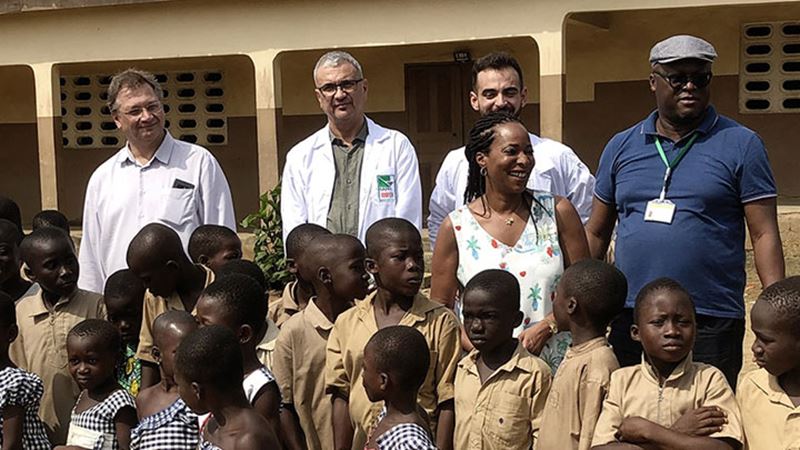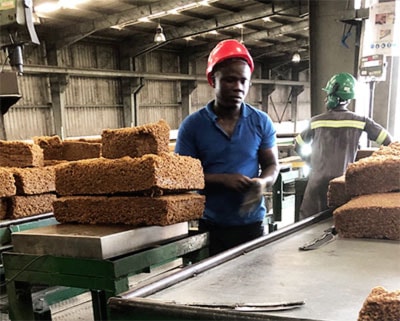The Ivory Coast: Taking social responsibility seriously during a price squeeze

Trelleborg visited SAPH’s largest rubber facility in November 2018 and had a closer look not just at the production itself but also the extensive social projects, with living quarters, daycare, schools, cafeterias and health centers.
The natural rubber plantation in Bongo, in the southwestern Ivory Coast, is the largest in Africa and can produce 56,000 tons of natural rubber per year. Only 15 percent of the raw materials come from their own immediate plantations. The remaining portion comes to the facility in small shipments from smaller growers in the region, who are paid the going price by weight on the world market. Rubber can be harvested every month of the year except January and February.
The raw goods consist of what are referred to in the industry as “cup lumps.” “Lumps” are coagulated latex from the tree Hevea Brasiliensis that are siphoned into a cup. The color changes depending on how much time it spends drying out in the sun, becoming more yellowish-brown with increased exposure to sun and oxidation.
“The first step we take with a batch is quality control – that the raw material contains enough usable rubber. After that comes washing, mixing, cutting and drying,” explains quality manager Etienne Bertrand (left in picture above) while he leads us visitors through the process in the factory.
Protective equipment

A striking detail is the large, graffiti-like reminders on the walls to wear protective equipment: helmet, boots, visors and, if necessary, hearing protection. As far as we can see, the reminders are being taken seriously. This is clear when you look at the accident frequency rate which has decreased to a level just over 3, or 13 accidents for the entirety of 2017.
The introductory washing phase uses a great deal of water in large tubs. The facility has recently invested in a comprehensive water cleaning site, with large basins in the factory, the goal of which is to be able to recycle the water used in the process. The recycling process is not yet perfected, but it has reached a level where the purified water can be used for the first step of the industrial process and things like watering plants.
After drying, a finished bale of natural rubber is yellow-brown in color and weighs 35 kg. The plastic-wrapped sacks are stacked on a pallet, and each pallet consists of 36 sacks, which collectively weigh approximately 1260 kg.
Around 2,000 tons of natural rubber of varying degrees of quality are stored on pallets in the large warehouse at the end of the production chain. Every pallet is inspected at the internal laboratory, whose purpose is to ensure quality through obligatory tests to find any impurities. The test results are saved so that any customer compensation claim can be tracked and double-checked.
Out in the plantation
The production in the factory itself looks very professional and appears to be on per with European standards. But how are the conditions out in the field, in the adjacent plantation? We follow a team of tappers.
Even they wear protective gear like boots and vests and the latest addition, safety goggles, has drastically reduced the number of plantation accidents.
The work goes at a high tempo: a tapper has less than 20 seconds per tree to make the right cut and flip the cup to collect the rubber. But everyone has gone on a 21-day course to learn how to cut optimally. The pay level is rather low by European standards, lower than for a freelance tapper who works for the village’s smaller rubber tree owners.
The big difference for a tapper hired by the facility are the benefits that come with the job: the opportunity to live in the nearby “artificial villages” that the company has built in direct connection to the factory, free access to water and electricity in these living quarters, daycare and school in locally run primary schools for the smaller children and not least of all, basic insurance and access to health care.
Social responsibility
It is maybe this comprehensive social responsibility that is the biggest difference between operating a manufacturing facility of this size in this part of Africa compared with Western Europe or North America. The facility must accept a great deal of local responsibility, otherwise disputes, protests and so on can easily occur. Significant fixed costs that are directly related to its workforce fall under the heading Corporate Social Responsibility (CSR).
“There really is no alternative. We have to take on a great deal of responsibility, otherwise it would be impossible to run an operation as large as ours, with almost 1,300 employees,” says Henriette Gomis-Billon (second from right in picture above), who is responsible for sustainability and communication in the SIFCA Group, the main owner of SAPH.
One good side of taking on so much responsibility is that it means many benefits for the villages neighboring the ones owned by the company. These villages can also use the health center and its doctors and nurses, for example during childbirth.
When we visit the health center, several women are sitting and waiting to be examined, and a mother and her baby are resting in a room after the morning’s birth. Generally speaking, the standard and equipment quality are higher than at the equivalent State-owned centers.
Its own ecosystem
Role delegation between the state and a large private operation like this is different here than in Europe. In this region, many of the services that the state usually provides are taken care of by the large rubber producer. And the limit is not at the company villages.In the areas just outside these villages, the company provides support to high schools in the form of materials and the construction of new buildings – we see an example of this and have the situation described by a principal and a teacher. The company also builds school canteens with support from local women’s groups for food supply and preparation, with the theme “a hungry belly has no ears.”
“An entire ecosystem has sprung up around the facility in Bongo,” says Rosman Jahja (second from left in picture above), VP of Corporate Responsibility at Trelleborg AB, who visited the facility. “And the operation gives independent rubber farmers a chance to earn income, better than if they grew cacao, which you can only harvest twice a year. Unfortunately, oversupply in combination with a low rubber price has led to economic development stalling somewhat in the last few years. But there is no doubt that the facility is contributing to the social safety net in just that area.”
Read more about Trelleborgs: Compliance, Resources and Social Engagement